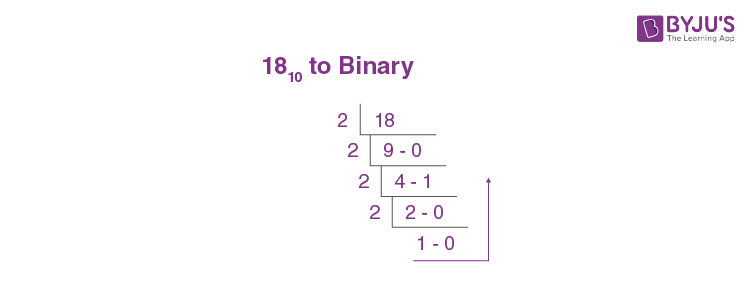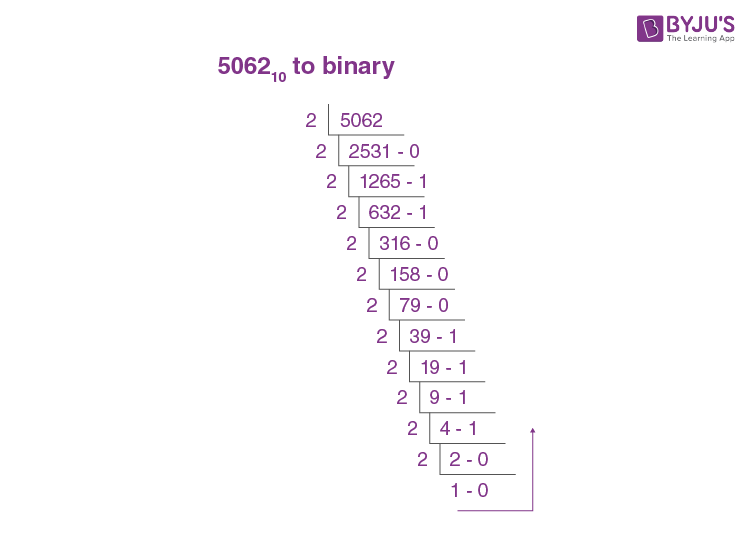The number system conversion questions and answers presented here will undoubtedly aid students in gaining a better understanding of the concept. Computer technology is one of the most important applications of the number system. The binary number system is used by computers, while people prefer the hexadecimal number system since it is easier to understand. As a result, a number system conversion is necessary. Several questions about number system conversion appear on practically every board exam. Students can use these questions to acquire a quick overview of the topics and practise them in order to gain a better knowledge of the subject. You can also check your answer against the answer on our page.
|
What is Meant by Number System Conversion? The conversion of one number system to another using number system formulas is known as a number system conversion. For instance, the decimal number system can be converted into a binary number system and vice versa. These number systems have a distinct representation that allows us to perform arithmetic operations like addition, subtraction, and division. There are several distinct types of number systems, with the following four being the most common:
Also, read: Number System. |
To completely grasp the idea, practice the number system conversion questions and solutions provided below.
Number System Conversion Questions with Solutions
|
Conversion from Decimal Number System to Other Bases: The steps below are used to change a number from the decimal number system to the binary/octal/hexadecimal number system. The processes for converting a number from the decimal system to another number system are shown. Step 1: Determine the desired number’s base. For example, if we need to convert a particular number to the octal system, the required number’s base is 8. Step 2: In the quotient-remainder form, divide the given number by the base of the needed number and write the quotient and remainder. Repeat the procedure until the quotient will be less than the base (by dividing the quotient by the base again). Step 3: In the octal number system, the specified number is found by writing the last quotient and all the remainders from bottom to top. |
1. Convert the number 1810 to the binary system.
Solution:
Given: 1810.
Now, we have to convert the decimal system to the binary number system. Hence, the desired number’s base is 2.
Step 1: Divide 18 by 2, we get: quotient = 9 and remainder = 0
Step 2: Divide 9 by 2, we get: quotient = 4 and remainder = 1
Step 3: Divide 4 by 2, we get: quotient = 2 and remainder = 0
Step 4: Divide 2 by 2, we get: quotient = 1 and remainder = 0
Now, write the quotient obtained in step 4 the remainder from step 4 to step 1.
Hence, the binary equivalent of 1810 is 100102.

2. Convert the number 506210 to the binary system.
Solution:
Given: 506210.
Now, we have to convert the decimal system to the binary number system. Hence, the desired number’s base is 2.
Step 1: Divide 5062 by 2.
⇒ Quotient = 2531 & Remainder = 0
Step 2: Divide 2531 by 2.
⇒ Quotient = 1265 & Remainder = 1
Step 3: Divide 1265 by 2.
⇒ Quotient = 632 & Remainder = 1
Step 4: Divide 632 by 2.
⇒ Quotient = 316 & Remainder = 0
Step 5: Divide 316 by 2.
⇒ Quotient = 158 & Remainder = 0
Step 6: Divide 158 by 2.
⇒ Quotient = 79 & Remainder = 0
Step7: Divide 79 by 2.
⇒ Quotient = 39 & Remainder = 1
Step 8: Divide 39 by 2.
⇒ Quotient = 19 & Remainder = 1
Step 9: Divide 19 by 2.
⇒ Quotient = 9 & Remainder = 1
Step 10: Divide 9 by 2.
⇒ Quotient = 4 & Remainder = 1
Step 11: Divide 4 by 2.
⇒ Quotient = 2 & Remainder = 0
Step 12: Divide 2 by 2.
⇒ Quotient = 1 & Remainder = 0
To get the equivalent binary number for the decimal representation 506210, write the quotient obtained in step 12 and the remainder from step 12 to step 1.
Therefore, 506210 = 10011110001102.

3. Convert 15910 to the octal number system.
Solution:
Given: 15910
Here, the required base number is 8. (i.e., octal number system). Hence, follow the below procedure to convert the decimal system to the octal system.
Step 1: Divide 159 by 8.
⇒ Quotient = 19 & Remainder = 7
Step 2: Divide 19 by 8.
⇒ Quotient = 2 & Remainder = 3
Since, the quotient “2” is less than “8”, we can stop the process.
Therefore, 15910 = 2378

4. Convert 38010 to the hexadecimal number system.
Solution:
Given: 38010
Now, we have to convert the decimal system to the hexadecimal number system.
So, divide the given number by 16.
Step 1: Divide 380 by 16.
⇒ Quotient = 23 & Remainder = 12 (12 can be represented as “C” in the hexadecimal number system)
Step 2: Divide 23 by 16.
⇒ Quotient = 1 & Remainder = 7
As the quotient 1 is less than 16, stop the process.
Hence, 38010 = 17C16.

|
Conversion from Other Bases to Decimal Number System The steps below are used to convert a number system from the binary or octal or hexadecimal system to the decimal system. Step 1: Starting with the rightmost digit, multiply each digit of the provided number by the exponents of the base. Step 2: Each step we take from right to left, the exponents should increase by one, such that the exponents start with 0. Step 3: Simplify and add each of the above-obtained products. |
5. Convert the binary number 110010112 to the decimal number system.
Solution:
Given binary number: 110010112
Now, multiply each digit of the given binary number by the exponents of the base, starting with the right to left such that the exponents start with 0 and increase by 1.
Hence, the digits from right to left are written as follows:
1 = 1 × 20 = 1
1 = 1 × 21 = 2
0 = 0 × 22 = 0
1 = 1 × 23 = 8
0 = 0 × 24 = 0
0 = 0 × 25 = 0
1 = 1 × 26 = 64
1 = 1 × 27 = 128
Now, add all the product values obtained.
= 1 + 2 + 0+ 8 + 0 + 0 + 64 + 128
= 203
Hence, the decimal equivalent of 110010112 is 20310.
I.e., 110010112 = 20310.
Alternate Method:
110010112 = (1 × 27) + (1 × 26) + (0 × 25) + (0 × 24) + (1 × 23 ) + (0 × 22) + (1 × 21 ) + (1 × 20 )
110010112 = 128 + 64 + 0 + 0 + 8 + 0 + 2 + 1
110010112 = 20310.
6. Convert the octal number 7148 to the decimal number.
Solution:
Given octal number: 7148
Since the base of the octal number system is 8, we have to multiply each digit of the given number with the exponents of the base.
Thus, the octal number 7148 can be converted to the decimal system as follows:
7148 = (7 × 82) + (1 × 81) + (4 × 80)
7148 = (7 × 64) + ( 1 × 8) + (4 × 1)
7148 = 448 + 8 + 4
7148 = 46010
Hence, the decimal equivalent of the octal number 7148 is 46010.
7. Convert 111012 to the decimal number system.
Solution:
Given binary number: 111012
Now, multiply each digit of 11101 with the exponents of the base, such that the exponents start with 0, and increase by 1 when moving from right to left.
So, 111012 = (1 × 24) + (1 × 23 ) + (1 × 22) + (0 × 21 ) + (1 × 20 )
111012 = 16 + 8 + 4 + 0 + 1
111012 = 2910
Hence, the decimal number system 2910 is equivalent to the binary number system 111012.
8. Convert the hexadecimal number 2C4 to the decimal number system.
Solution:
Given hexadecimal number is 2C4.
As we know, the base of the hexadecimal number is 2C4.
Thus, 2C4 in the decimal number system is given as follows:
2C416 = (2 × 162) + (12 × 161) + (4 × 160)
2C416 = (2 × 256) + (12 × 16) + (4 × 1)
2C416 = 512 + 192 + 4
2C416 = 70810
Hence, the hexadecimal number 2C416 is equivalent to 70810.
|
Conversion from One Number System to Another Number System: To change a number from one number system (octal or binary or hexadecimal) to another, first convert it to the decimal system, then use the above-mentioned techniques to convert it to the needed number systems. |
9. Convert 10012 to octal number system.
Solution:
Given: 10012.
To convert the binary number system to the octal number system, first we have to convert the binary system into decimal system, and then convert the decimal system to the octal number.
Conversion from Binary System to the Decimal System:
10012 = (1 × 23) + (0 × 22) + (0 × 21) + (1 × 20)
10012 = (1 × 8) + (0 × 4) + (0 × 2) + (1 × 1)
10012 = 8 + 0 + 0 + 1
10012 = 910
Conversion from Decimal Number System to the Octal Number System:
Here, we have to convert 910 to the octal system, and the required base is 8.
Hence,
Step 1: Divide 9 by 8.
⇒ Quotient = 1 & Remainder = 1
Since, quotient “1” is less than “8”, we cannot proceed further.
Therefore, the octal equivalent of 910 is 118
Hence, the octal number system equivalent to 10012 is 118.
10. Convert 6728 to the hexadecimal number system.
Solution: decimal= 442, hexa = 1BA
Given: 6728 (i.e., octal number system)
Conversion from Octal to Decimal Number System:
The conversion from the octal number system to the decimal system is as follows:
6728 = (6 × 82) + (7 × 81) + (2 × 80)
6728 = (6 × 64) + (7 × 8) + (2 × 1)
6728 = 384 + 56 + 2
6728 = 44210
Conversion from Decimal to the Hexadecimal Number System:
Now, the number in the decimal system is 44210.
Thus, the process of converting the decimal number system to the hexadecimal system is as follows:
Step 1: Divide 442 by 16
⇒ Quotient = 27 & Remainder = 10 (Number 10 in hexadecimal system is A)
Step 2: Divide 27 by 16
⇒ Quotient = 1 & Remainder = 11 (Number 11 in hexadecimal system is B)
So, 44210 = 1BA16
Therefore, the octal number 6728 equivalent to the hexadecimal number system is 1BA16.
Explore More Articles
- Perimeter and Area Questions
- Arithmetic Questions
- BODMAS Rule Questions
- Functions Questions
- Decimal to Binary Questions
- Conditional probability Questions
Practice Questions
Solve the following number system conversion questions:
- Convert 48910 to binary number system.
- Convert 4BC to the decimal number system.
- Convert 5468 to the hexadecimal number system.
Download BYJU’S – The Learning App to learn all Maths-related topics by exploring more interesting videos.
Comments